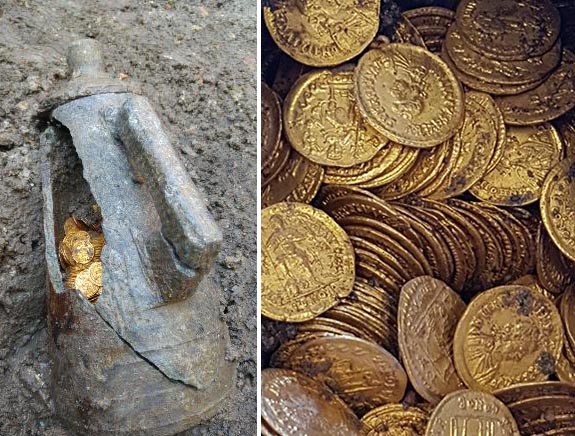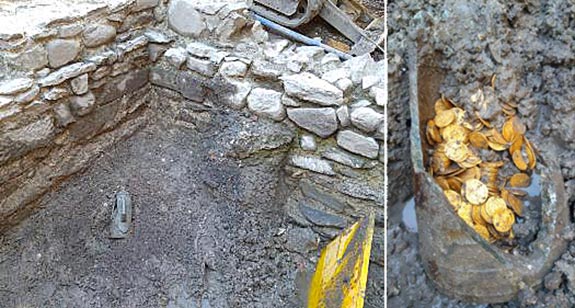September 17th, 2018
Archaeologists working in the basement of a demolished theater in Northern Italy recently unearthed a soapstone jar literally bursting with Roman gold coins dating back to the 4th and 5th centuries AD. The pristine coins were pulled from the site of the former Cressoni theater, which is located in Como, near the Swiss border.

Hundreds of coins bearing the engravings of emperors Honorius, Valentinian III, Leon I, Antonio and Libio Severo were found stacked neatly in the two-handled jar called an amphora. The newest of the coins was minted in 474 AD.
"We are talking about an exceptional discovery," local archaeology superintendent Luca Rinaldi told the Times of London. The superintendent couldn't guess what the coins might be worth, stating, instead, that their value was "inestimable."

The coins were sent to a restoration laboratory in Milan, where archaeologists, restorers and numismatists will try to piece together the story behind the exciting discovery.
For now, archaeologists believe the jar of gold coins had been hidden for safekeeping.
The jar was "buried it in such a way that in case of danger they could go and retrieve it," Maria Grazia Facchinetti, an expert in rare coins, told CNN. "They were stacked in rolls similar to those seen in the bank today."
Due to the orderly way in which the coins were placed in the jar, Facchinetti believes the owner of the hoard was not a private person.
"Rather it could be a public bank or deposit," she said.
The Cressoni theater had been shuttered in 1997, and the recent coin discovery took place while the property was being developed into residential apartments, according to Newsweek.
"We do not yet know in detail the historical and cultural significance of the find," Culture Minister Alberto Bonisoli said in a press release. "But that area is proving to be a real treasure for our archaeology. This discovery fills me with pride."
Credits: Photos courtesy of MiBAC (Italy's Ministry of Heritage and Cultural Activities).

Hundreds of coins bearing the engravings of emperors Honorius, Valentinian III, Leon I, Antonio and Libio Severo were found stacked neatly in the two-handled jar called an amphora. The newest of the coins was minted in 474 AD.
"We are talking about an exceptional discovery," local archaeology superintendent Luca Rinaldi told the Times of London. The superintendent couldn't guess what the coins might be worth, stating, instead, that their value was "inestimable."

The coins were sent to a restoration laboratory in Milan, where archaeologists, restorers and numismatists will try to piece together the story behind the exciting discovery.
For now, archaeologists believe the jar of gold coins had been hidden for safekeeping.
The jar was "buried it in such a way that in case of danger they could go and retrieve it," Maria Grazia Facchinetti, an expert in rare coins, told CNN. "They were stacked in rolls similar to those seen in the bank today."
Due to the orderly way in which the coins were placed in the jar, Facchinetti believes the owner of the hoard was not a private person.
"Rather it could be a public bank or deposit," she said.
The Cressoni theater had been shuttered in 1997, and the recent coin discovery took place while the property was being developed into residential apartments, according to Newsweek.
"We do not yet know in detail the historical and cultural significance of the find," Culture Minister Alberto Bonisoli said in a press release. "But that area is proving to be a real treasure for our archaeology. This discovery fills me with pride."
Credits: Photos courtesy of MiBAC (Italy's Ministry of Heritage and Cultural Activities).


